Respiratory Medicine
| Patient name: |
| Hospital number: |
| Completed by: |
| Date issued: |
What is Chronic Obstructive Pulmonary Disease (COPD)?
Chronic obstructive pulmonary disease (COPD) is an umbrella term for a group of lung conditions that cause breathing difficulties. These conditions are:
- Emphysema – this is damage to the air sacs in the lungs. The air sacs play a vital role in the exchange of oxygen.
- Bronchitis – is inflammation and narrowing of the airways. This makes moving air in and out of the lungs laboured. People with bronchitis often produce sputum or phlegm regularly.
COPD is a common and irreversible long-term condition. It is often diagnosed through spirometry and is caused through inhalation of toxic gases such as, smoking or environmental factors. Symptoms may not be recognised at first therefore a diagnosis can be delayed.
An exacerbation of COPD is a flare up of your condition – this can be infective or non-infective. An infective exacerbation will require antibiotics, a non-infective exacerbation will not.
What is a COPD self-management plan?
A COPD self-management plan is designed to help patients with a diagnosis of COPD understand their condition, recognise deterioration in order to act quickly, get the correct treatment and help when needed.
Symptoms of COPD
- Becoming short of breath easily when doing everyday tasks
- Having a cough that lasts a long time
- Producing more sputum (phlegm)
- Wheeze, rattle or whistling sound from the chest.
Triggers that may cause an exacerbation
- Smoking or being around second-hand smoke
- Weather conditions – hot or cold temperatures
- Air pollution – dusty environments, exhaust fumes
- Aerosols – deodorants, hair sprays, air fresheners
- Strong smells – perfumes or cleaning products
Anxiety
If you are aware of what makes your symptoms worse, you can try to avoid the trigger. Being aware of what your symptoms are like when you are well, is useful to recognise what is normal for you. Any changes to your normal symptoms may require further assessment.
Medications
Inhalers
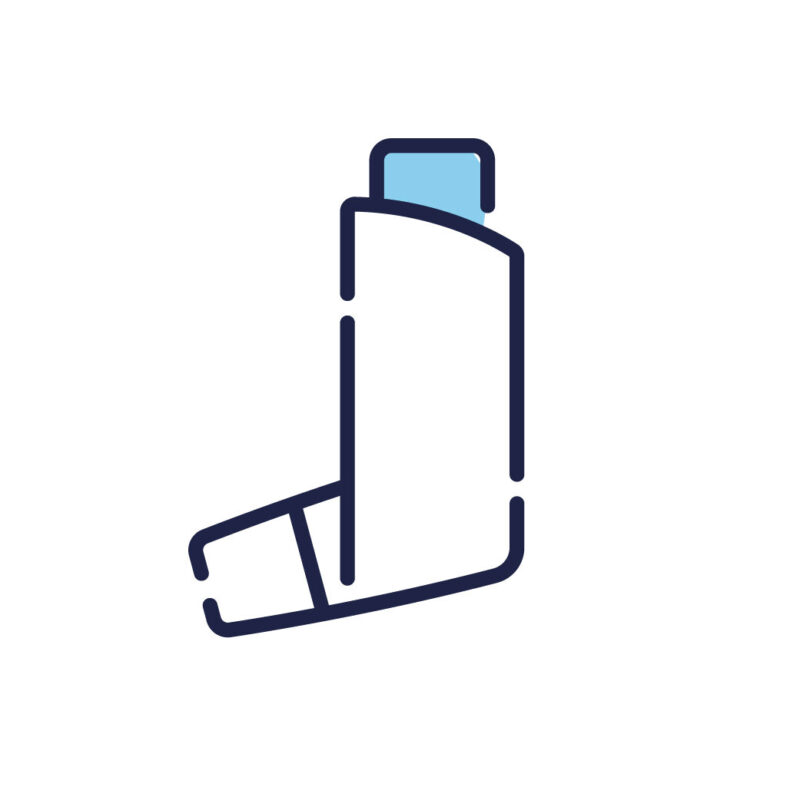
Inhalers are used to open up your airways and reduce inflammation. Long-acting inhalers aim to open your airways for 12 to 24 hours, this should be taken regularly. You may also be supplied with a shorting acting inhaler (usually blue) to use in episodes of breathlessness requiring quick relief – these usually take effect within 15 minutes and last between 4 and 6 hours.
Sometimes an inhaled steroid is used to treat inflammation in the lungs, and they aim to prevent a flare-up (exacerbation). If you also have asthma, you will always be prescribed a steroid inhaler.

Spacer device
Spacer devices are used with your metered dose inhaler (MDI) to allow more medication to reach your lungs; they can also be useful for people with poor dexterity.
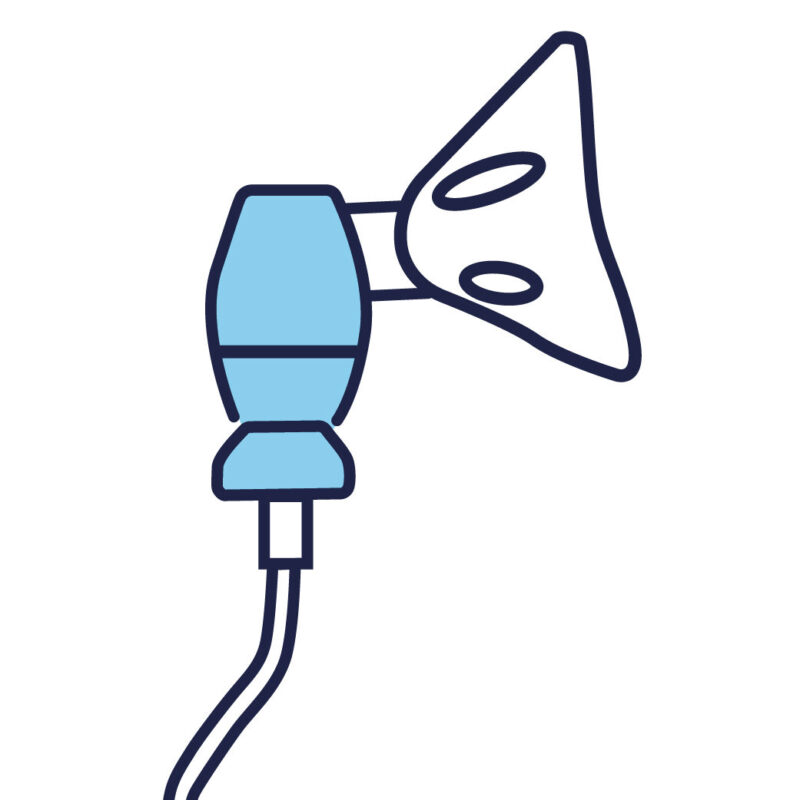
Nebuliser
Some people who are unable to use their inhalers or have severe episodes of breathlessness may use a nebuliser. If your inhaler is used correctly, it can be as beneficial as a nebuliser.
Mucolytic
These drugs hep with sputum clearance, they make sputum thinner and easier to cough up.
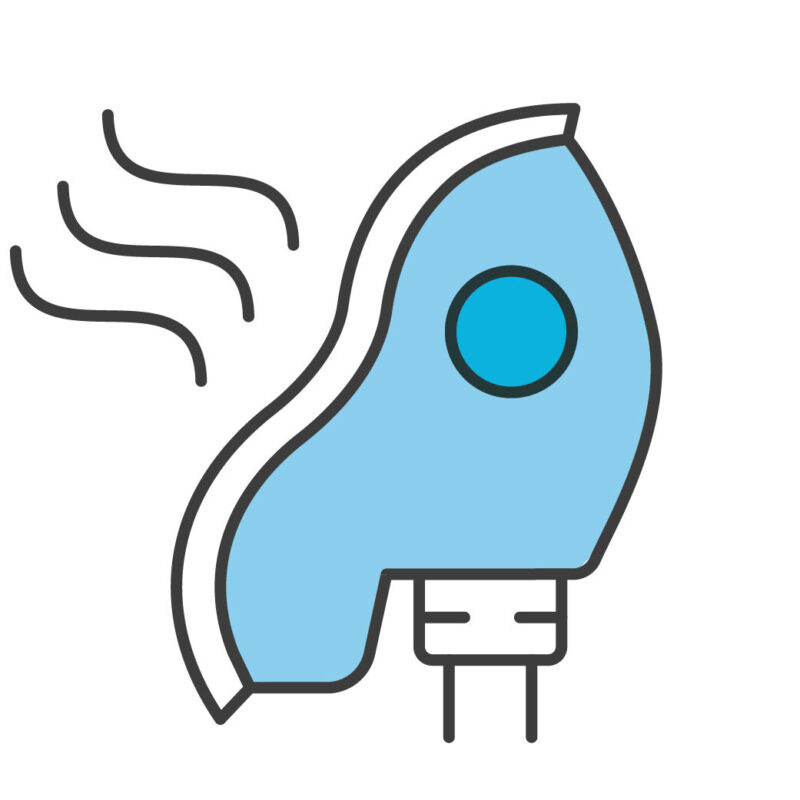
Oxygen
Oxygen is used in people who cannot maintain their oxygen levels. A person needs to be assessed by the oxygen team to decide if they require oxygen. It does not help breathlessness.
Rescue medication
Your GP may prescribe you a rescue pack with antibiotics and steroids; this is to be used in the event of an exacerbation. You must inform your GP if you have used your rescue pack – if you are using steroids regularly you must be reviewed by your GP. Rescue packs are used rarely.
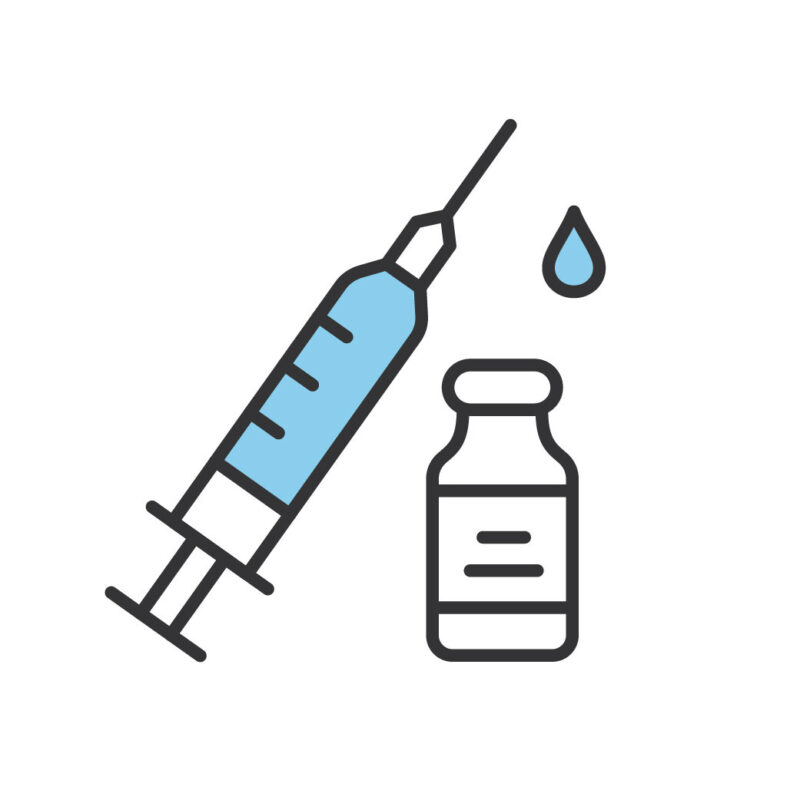
Vaccinations
Keeping up to date with your vaccinations is very important. You should have your flu jab every year and keep up to date with the COVID-19 vaccination. Remember to have your pneumonia vaccine; you should only need this once every ten years.
Stopping smoking
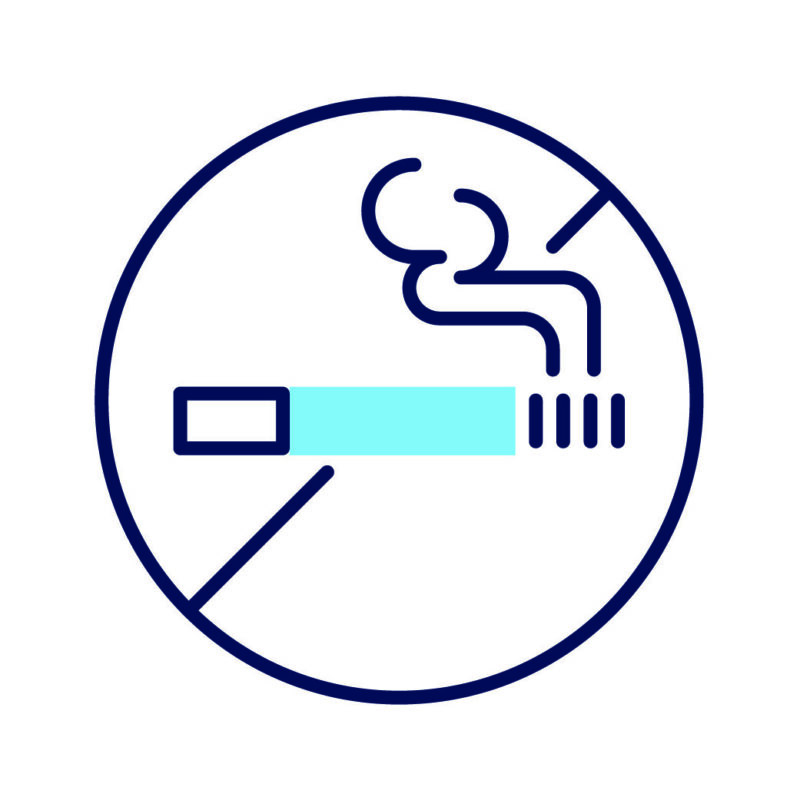
Stopping smoking is one of the best things you can do for COPD, stopping smoking won’t repair the damage already present but it can slow the pace of decline. Everyone’s lung function deteriorates with age but if you are smoking this decline will happen more rapidly. It is proven that stopping smoking with support will make you more likely to give up for good and prevent you from relapsing.
You can self-refer at www.stopsmokingsouthtees.co.uk
Keeping active
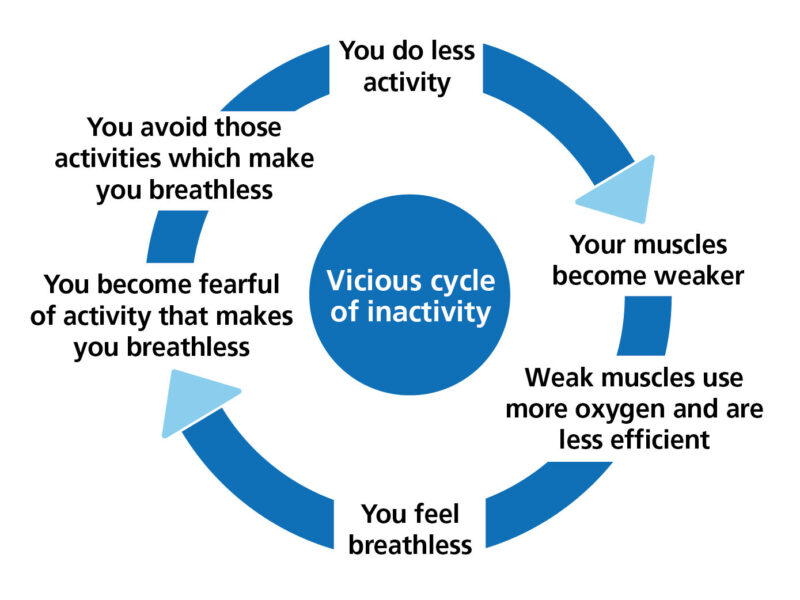
Keeping active is important as it prevents deconditioning. This is where your body adapts to doing less, affecting your quality of life and fitness.
People with COPD are more likely to lose weight and have a reduced appetite, it is important to maintain a healthy weight through diet. If it is required a healthcare professional can refer you to a dietician to help you maintain your weight.
Managing breathlessness
Breathlessness is common in COPD, this can be very frightening for some people. There are many ways to cope with breathlessness and still have a good quality of life. A physiotherapist maybe able to provide breathing techniques.
Exacerbation of COPD (Flare-up)
Symptoms can be different day-to-day. If symptoms appear worse for more than two days, this is an exacerbation.
Symptoms of an exacerbation
- More breathless
- Coughing more
- Changes in colour, consistency and volume of sputum (phlegm)
Chest tightness
- Reduced walking distance
- Swollen ankles
Lethargy (feeling tired)
Remember
- Exacerbations can be caused by an infection or there may be no specific cause.
- You must remember to inform your GP if you use your rescue pack and check the rescue pack is not out of date.
- You must call 999 if you are very unwell and have serve breathlessness, chest pain or coughing up blood.
- If you have more than two courses of steroids in the last year you must have a review from your GP.
- It is important to remember that steroids have long-term side effects and it is important to only use them if required.
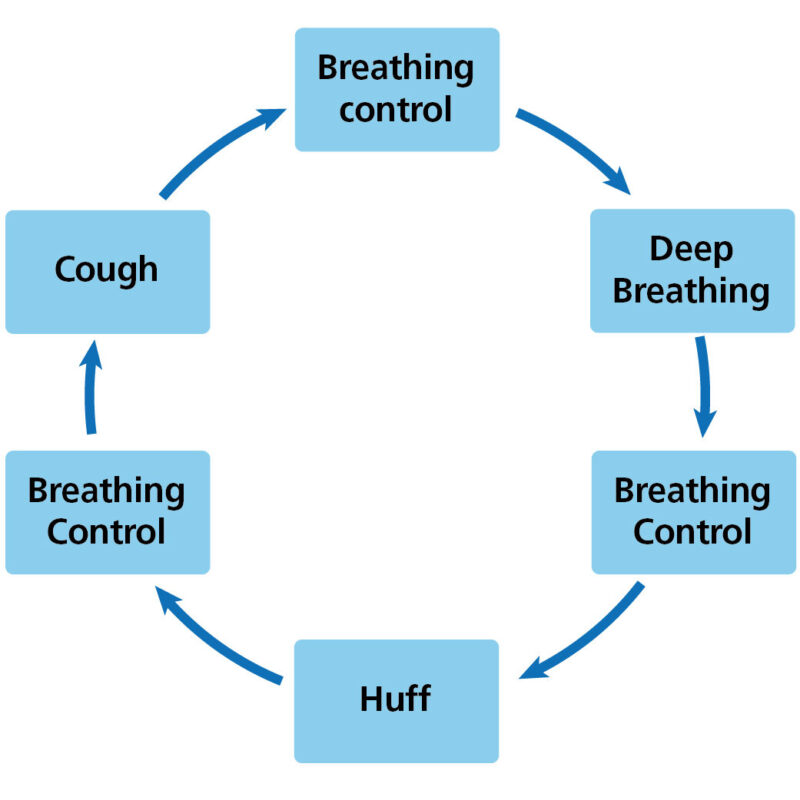
Active cycle of breathing technique
Active cycle of breathing is a technique used to loosen and move phlegm or secretions. The technique consists of breathing control, deep breathing, huffing and coughing. It is important to complete ACBT regularly to avoid chest infections.
The diagram right, is an example of how to complete a cycle of ACBT.
Start in a comfortable seated position with your arms and shoulders relaxed and your feet on the floor.
Breathing control
Place one hand above your navel and one hand on your chest. You will feel your abdomen rise and fall as you inhale and exhale. Take 5 to 6 gentle breaths in through your nose and out through your mouth. Complete breathing control between each stage of the cycle.
Deep breathing
Take slow deep breaths in through your nose, hold for 2 to 3 seconds. Gently breathe out through the mouth. Repeat 3 times. Keep your shoulders relaxed during deep breathing.
Huff
A huff allows you to exhale out through your mouth without coughing. Huffing aids the mobilisation of secretions from the small airways into the large airways.
Start by taking a medium sized breath in through your nose; forcefully exhale out through an open mouth. Keep your mouth open wide in an “O” shape during exhalation. Imagine you are steaming up some glasses or a mirror. Do not complete more than 2 huffs per cycle.
If you do not clear your phlegm with a huff, complete a cycle of breathing control and cough to clear secretions into a pot or tissue.
How often should I complete ACBT?
It is important to complete ACBT to keep your chest clear. Your respiratory physiotherapist will advise you regarding frequency.
If you have an increase in sputum production or an exacerbation you may find it beneficial to increase the frequency of ACBT throughout the day to keep your chest clear.
Vaccinations
| Year | Flu | Covid-19 | Pneumonia or Pneumococcal in the last 10 years |
|---|---|---|---|
| 2023 | […] Yes […] No | […] Yes […] No | […] Yes – Year given: […] No |
| 2024 | […] Yes […] No | […] Yes […] No | |
| 2025 | […] Yes […] No | […] Yes […] No | |
| 2026 | […] Yes […] No | […] Yes […] No |
Smoking history
| Are you currently smoking? | […] Yes […] No |
| Have you ever smoked? | […] Yes […] No |
| How many per day? | […] Yes […] No |
| How many years did/have you smoke(d) for? | […] Yes […] No |
| Have you ever lived with someone who smoked? | […] Yes […] No |
Your daily symptoms
| Do you cough up sputum when you are well? | […] Yes […] No […] Occasionally |
| What colour is your sputum when well? | […] Yes […] No |
| How much do you cough up? For example, Enough to fill up a teaspoon, tablespoon, eggcup over 24 hours | […] Yes […] No |
Exercise tolerance
How far can you walk when you are well, if you notice your exercise tolerance has declined, that can also be an indication of a flare up of your COPD.
| I only get breathless with strenuous exercise | |
| I get short of breath when hurrying on level ground or walking up a slight hill | |
| On level ground, I walk slower than people of my age because of breathlessness, or I have to stop for breath when walking at my own pace on the level | |
| I stop for breath after walking about 100 yards or after a few minutes on level ground | |
| I am too breathless to leave the house or I am breathless when dressing or undressing |
Exacerbation flow chart
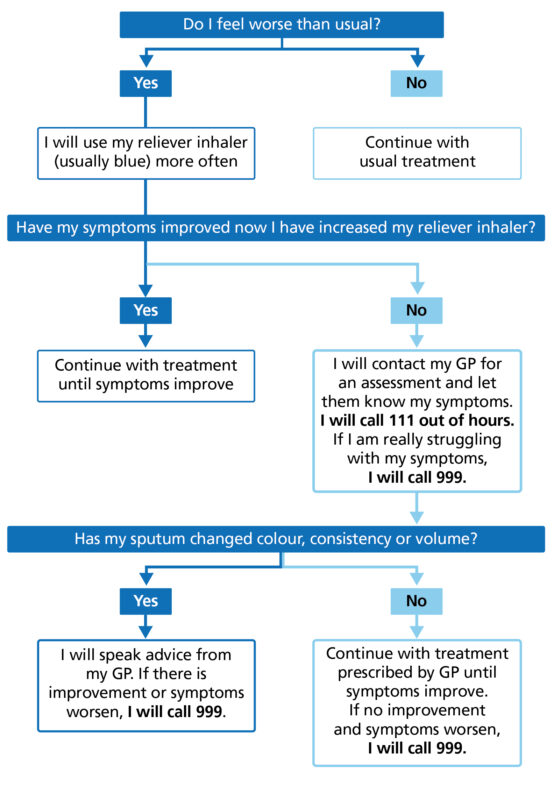
Exacerbation tracker
| Date flare-up began | Date steroids started | Date antibiotics started | How long did symptoms last | Did you require hospital admission |
|---|---|---|---|---|
If you require steroids or antibiotics record them here, this will allow you to see if your exacerbations (flare-up) are responding to treatment.
Useful contacts
- Respiratory Nursing team at JCUH
Telephone: 01642 854241
Email: [email protected] - Respiratory Nursing team at FHN
Telephone: 01609 763109 - British Lung Foundation (BLF)
Telephone: 0300 222 5800 - Air Liquide (oxygen assessment for Middlesbrough, Redcar and Cleveland)
Telephone: 08000 223445 - Dolby Vivisol (oxygen suppliers for Middlesbrough, Redcar and East Cleveland) Telephone: 0800 917 9840
- Middlesbrough, Redcar and East Cleveland Community Matron Team
Telephone: 01652 065070 (option 2 then option 1) - Stop smoking South Tees
www.stopsmokingsouthtees.co.uk
Patient experience
South Tees Hospitals NHS Foundation Trust would like your feedback. If you wish to share your experience about your care and treatment or on behalf of a patient, please contact The Patient Experience Department who will advise you on how best to do this.
This service is based at The James Cook University Hospital but also covers the Friarage Hospital in Northallerton, our community hospitals and community health services.
To ensure we meet your communication needs please inform the Patient Experience Department of any special requirements, for example; braille or large print.
T: 01642 835964
E: [email protected]